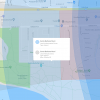Hey everyone,
I'm hoping to purchase a mavic shortly, but would like to know if I'll be able to fly it at / around my house (for fun, not commercial). Unfortunately I'm located pretty close to an airport, so I'm in some zones associated with it but not others. I've looked at the location on both airmaps and the DJI geo-map, but I'm unsure of what the implications of the various zones are.
Can I fly just with height restrictions? Can I use self-unlock and be fine? Or is the authorization required going to be impossible to get and I won't be able to fly at all?
Please see attached images from AirMaps and DJI Geo-maps for details. (The mouse pointer is placed at my location on the overview map shots)
Thanks for the help.




I'm hoping to purchase a mavic shortly, but would like to know if I'll be able to fly it at / around my house (for fun, not commercial). Unfortunately I'm located pretty close to an airport, so I'm in some zones associated with it but not others. I've looked at the location on both airmaps and the DJI geo-map, but I'm unsure of what the implications of the various zones are.
Can I fly just with height restrictions? Can I use self-unlock and be fine? Or is the authorization required going to be impossible to get and I won't be able to fly at all?
Please see attached images from AirMaps and DJI Geo-maps for details. (The mouse pointer is placed at my location on the overview map shots)
Thanks for the help.

















